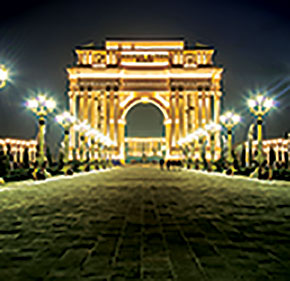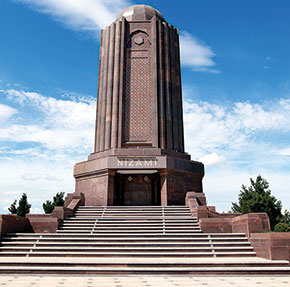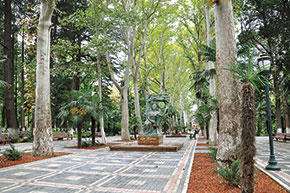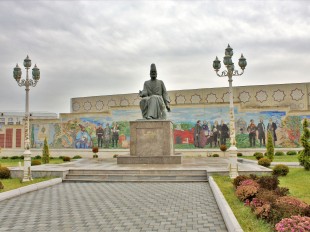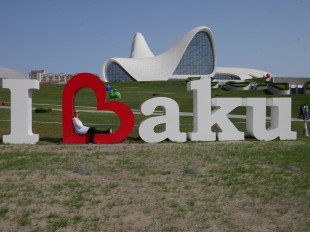Intrigued by Ganja’s rich history and tourist potential, Tom Marsden travelled to western Azerbaijan to explore the city’s past and present and to learn about the fascinating legacy left by German settlers in the region. What he found was a city of red bricks, unusual attractions and uniquely Ganjan hospitality.
The Kerimovs’ apartment was warm and cosy, the smell of home cooking – lamb chops, pickled salads, fresh fig compote and pomegranates - drifted into the lounge where a large gathering of friends, neighbours, sons, nephews and nieces had spontaneously and somewhat coincidentally come together to welcome returning family members, visiting acquaintances and me, an Englishman they had found wandering the foot of the lesser Caucasus mountains earlier in the day.
GANJA
Typically for Ganja, the Kerimovs live in Soviet-era five-story housing, which, along with a few withered factory carcasses and once impressive Soviet-realist murals, still dominates Ganja’s suburban landscape today. Mr Kerimov explained that architecturally speaking relatively little has changed over the last twenty years but whilst the city’s recent past is all too clear, several old mosques and hammams, a bustling bazaar and 19th century red brick houses offer a glimpse into a far deeper, more complex and multi-layered history.
It’s a history that blends periods of Arab and Mongol influence, as part of Persian, Ottoman and Russian Empires and more recently within the USSR. In between there have been rare pockets of independence, including a brief spell as Azerbaijan’s capital in 1918, whilst Baku was under the Bolshevik-Dashnak Central-Caspian Dictatorship. Known as Elizavetspol under Tsarist Russia and then Kirovabad from 1935 until 1991, Ganja is also best-known as the home of one of Azerbaijan’s most revered figures, the 12th century poet Nizami, whose mausoleum is located on the eastern road into the city.
The History Museum on Ataturk Avenue is a logical place to start. Although the staff may be surprised to have a visitor, the small museum runs exhibits from the Bronze Age to the modern day. A particularly interesting collection of well-composed black and white images arranged according to themes such as sport, work, agriculture and more, form a rich documentary of city life throughout the greater part of the 20th century and could almost be called ‘Life in Ganja during the USSR.’
Exit the museum and hop over the road and you’ll find the imperious City Hall building, completed in 1949 and radiating Soviet glory. In front spans a vast rectangular square contrasting a statue of Heydar Aliyev at one end with the 17th century Shah Abbas Mosque at the other. The entire area, which includes the grand Ganja Hotel and Academy of Sciences, is elegantly illuminated and serves as a springboard to explore the few tourist attractions nearby such as the Prince’s Park, former Parliament of the Azerbaijan Democratic Republic, and the unusual Bottle House.
These are all easily seen in a day and on foot, but Ganja’s selling points are less its attractions and rather its laid-back, undiscovered charm, the absence of traffic and the thrill (or not) of being one of the only westerners in town. The city is also undeniably and at times overwhelmingly hospitable and offers perhaps a more immersive Azerbaijani experience than you might find in the capital, Baku.
A few blocks south of the square, the unassuming red brick Azerbaijan State Agricultural University leaves little reminder of its glory days as the brief home of the quickly assembled government of the Azerbaijan Democratic Republic in 1918. On my visit, even the doorkeepers seemed to have forgotten and I was reluctantly shifted on to the miniscule museum over the road to encounter another gaggle of surprised but friendly staff.
Besides several churches, one Russian, another Armenian, the other site worth a peek is the curious Bottle House, whose exterior is decorated with thousands of bottles (roughly 50,000 in total) and a portrait of a Red Army soldier painted on the underside of the roof. Reportedly, the house was created by Ibrahim Jaffarov as a monument for his brother Yusif, who never returned from World War II.
Across the city centre, opposite a statue to Nizami and next to the Ganja River, The Kapaz Hotel is an entirely different architectural curiosity. Built in 1961, the hotel’s drab, cubic appearance and utterly out-dated interior suggests it hasn’t been used since the fall of the USSR. This isn’t the case of course but the Kapaz is such a time warp with its antiquated Russian furniture and signage, dezhurnayas (women on duty), broken lift and all over concrete that, with rooms from 20 AZN per night, it should also be considered a (barely) living museum itself.
GANJA HOSPITALITY
Ganja was a city of chance meetings and fine hospitality and the rare westerners who visit the city are bound to attract the locals’ attention. In a run-of-the-mill newsagents on Ataturk Avenue I met Tahir Abbasov, a local artist with a unique family history. Tahir’s great uncle Mirza Abbas Abbaszadeh was a prominent educationalist, publicist and public figure around the time of the Azerbaijan Democratic Republic, who promoted Azerbaijani language teaching in local schools and authored ABC textbooks for young children. A cousin, another Abbaszadeh, was honoured for services to the Italian partisan movement in World War II, during which many Azerbaijanis fought in the Red army. The family used to own the entire red brick corner to the south west of Prince’s Park, but their territory has since shrunk to Tahir’s cramped workshop and an apartment next door.
I crossed into the Prince’s Park shortly afterwards, attracted by the dense green trees, neat paths and small clusters of tea drinkers in peaked caps and dark jackets. An hour later, through a bizarre chain of events which began with photographing snowflakes and developed into a stroll with an English teacher named Agasif from Mingechevir, I found myself giving an impromptu English lesson on Heydar Aliyev Avenue to students preparing for university entrance exams. Prior to that, I’d been invited for a lunch of dovga (made from yoghurt, herbs and rice), cutlets, potatoes and beetroot salad with the college’s small teaching staff.
Later on, I wandered through Ganja’s thousand year-old bazaar bordered by characterful Ladas, teahouses and small traders. A beautiful green-domed mosque perched at the bazaar’s eastern edge, around which women wearing colourful headscarves were selling fresh herbs and vegetables. Inside the bazaar, a few dozen metres from here, were the butchers, the grocers, the cobblers, the clothes traders, the hairdressers, the fishmongers, the teahouses, the nut sellers, the handymen, the porters, the biscuitiers and many more.
GOYGOL
Ten kilometres from Ganja the small town of Goygol, still known amongst locals as Khanlar (it was renamed after a nearby lake in 2008 for no apparent reason), sits at the bottom of the lesser Caucasus Mountains. Its village feel, crisp air and teasing views make it a pleasant escape from Ganja, from where a simple twenty-five minute bus trip (from Narimanov Street) leads to alpine houses, perfectly linear streets and a pervasive sense of mountain stillness - all a legacy of Goygol’s original German settlers.
The Germans knew the best places to live, insisted Larissa Danilova, a local entrepreneur, whose restaurant still serves several old German recipes. Like many of Goygol’s residents, she lives in a house built by the Swabian German settlers who founded the town of Helendorf (now Goygol) in 1819. The founders had begun emigrating from the Duchy of Württemberg from 1816-17 to escape famine and upheaval and taken up an earlier invitation from Catherine II to settle in the Russian Empire.
With financial aid from Russia, the first German migrant columns made the arduous journey from the Danube, across the Austro-Hungarian Empire and on to Odessa, Rostov, Stavropol and Tiflis. Huge numbers died along the way, less than half the 6000 or so émigrés that left Württemberg reached Odessa. Some opted to stay there, others marched on, establishing German colonies along the way. Several sprung up around Tbilissi – Marienfeld, Elisabethtal, Alexandersdorf, Neu-Tiflis and others. And finally after two years of travelling, 127 families arrived to construct a new settlement at Helendorf.
Half a century later the Germans had established a successful wine trade (second half of the 19th century), producing in the lowlands of Helendorf and shipping the wine back to Germany and other parts of the Russian empire. Judging by the old black and white photographs exhibited in the Lutheran church, now a museum, the Germans developed a sophisticated and flourishing society, together with another émigré group – the Assyrians.
Larissa’s dark curly hair, light skin and strong facial features distinguish her from the almost entirely Azerbaijani population of modern day Goygol. She and her husband Theodor are one of only three remaining Assyrian families after the Assyrians first settled here in 1914. The Assyrians were invited to work in the wine plantations and as housekeepers and labourers for the Germans and an extraordinary German-Assyrian society blossomed during the early 20th century.
But looking at the dated photographs of the Helenendorf Germans at celebrations, schools, in orchestras and at sports events, with beaming smiles and a touch of decadence, it was saddening to think that only years later they would be deported to Kazakhstan and Siberia, for the most part never to return. The Assyrians experienced a similar fate and Larissa herself was born in Siberia. Meanwhile, the empty houses were filled with Armenian families from Karabakh and later by Azerbaijanis, and the unique German-Assyrian society forged during the early 20th century was never the same.
Only five German families ever returned and not a single one survives today. The man widely dubbed as the last German, Victor Klein, died a few years ago and his house has been left as an unofficial, dusty museum. Yet, Victor Klein was in fact better known as Victor Perepelitsin and actually half Polish.
He was just an ordinary man, Larissa said, lamenting that Victor’s house had attracted particular attention from tourists, guidebook writers and journalists. On the contrary, every house in Khanlar is history, Larissa insisted.
HAJIKAND
The road from Goygol winds its way gently up the slopes of the lesser Caucasus Mountains, through dense forests, isolated ramshackle dwellings and rustic teahouses. Larissa had insisted that summer was the best time to experience the rich countryside around Hajikand, but the light February snow covering, thickening the further we climbed, together with the white clouds of steam rising from the roadside teahouses created a magical wintery world I was glad to witness.
Continue along this road and you’ll eventually come to some of western Azerbaijan’s finest scenery - the crystalline Lake Goygol at the foot of Mount Kapaz, which has unfortunately remained off-limits to all but locals for many years, without any particular plans to reopen it, due to its proximity to the contact line.
The Germans never settled in Hajikand, situated slightly higher in the mountains and only a few kilometres from Goygol, although they must have ventured here on foot and spent their summers swimming in the lake below. In reality there was little to see when I arrived with a small band of Azerbaijanis who had offered to deliver me back to Ganja and our main reason for visiting was to stop for tea at a rickety shack, heated by a primitive metal stove.
The most interesting thing about this little town, local artist Rafat explained, is that the family of the revered Soviet spy Richard Sorge hailed from here. Other sources clearly suggest he was actually born in the suburbs of Baku but whatever the connection with Hajikand, Sorge was a Caucasian German and an undeniably fascinating character.
Sorge knew the Germans would attack the Soviet Union … but nobody believed him! Rafat said animatedly.
Sorge had been injured fighting for the Germans on the Western Front in WWI, joined the German Communist Party and then moved to Moscow in 1924. Soon after he was working for Soviet intelligence, often under journalist cover, and supplied vital information from Japan during World War II, most famously an advance warning of the Germans’ attack on the USSR (Operation Barbarossa) in 1941. He was arrested in Japan the same year, sent to prison and executed in 1944. It wasn’t until several decades later that his espionage exploits were fully recognised by the USSR, but today a park and monument remain in his honour in Baku.
The snow had thickened again by the beginning of our descent from Hajikand, yet a fairly continuous file of provincial Zhigulis were grinding up the wiggly road, one of which had slid and launched itself head first into a tree. We made our way cautiously back towards Goygol and onto the main road to Ganja, entering the city as the evening drew in. Ganjans were returning from work and the old pyatietazhki (five-story housing) were beginning to flicker with golden lights throughout the city’s suburbs.
The Kerimovs meanwhile were preparing the sort of boundless hospitality I had become used to during my short stay in Ganja, driven by a fascination in where I was from and a deep sense of responsibility. After a few hours, during which I’d learnt to peel a pomegranate and watched the Azerbaijani mugham equivalent of Britain’s ‘The Voice’, I set off for the station, boarded the overnight train and rolled back into Baku early the next morning.
The Kerimovs’ apartment was warm and cosy, the smell of home cooking – lamb chops, pickled salads, fresh fig compote and pomegranates - drifted into the lounge where a large gathering of friends, neighbours, sons, nephews and nieces had spontaneously and somewhat coincidentally come together to welcome returning family members, visiting acquaintances and me, an Englishman they had found wandering the foot of the lesser Caucasus mountains earlier in the day.
GANJA
Typically for Ganja, the Kerimovs live in Soviet-era five-story housing, which, along with a few withered factory carcasses and once impressive Soviet-realist murals, still dominates Ganja’s suburban landscape today. Mr Kerimov explained that architecturally speaking relatively little has changed over the last twenty years but whilst the city’s recent past is all too clear, several old mosques and hammams, a bustling bazaar and 19th century red brick houses offer a glimpse into a far deeper, more complex and multi-layered history.
It’s a history that blends periods of Arab and Mongol influence, as part of Persian, Ottoman and Russian Empires and more recently within the USSR. In between there have been rare pockets of independence, including a brief spell as Azerbaijan’s capital in 1918, whilst Baku was under the Bolshevik-Dashnak Central-Caspian Dictatorship. Known as Elizavetspol under Tsarist Russia and then Kirovabad from 1935 until 1991, Ganja is also best-known as the home of one of Azerbaijan’s most revered figures, the 12th century poet Nizami, whose mausoleum is located on the eastern road into the city.
The History Museum on Ataturk Avenue is a logical place to start. Although the staff may be surprised to have a visitor, the small museum runs exhibits from the Bronze Age to the modern day. A particularly interesting collection of well-composed black and white images arranged according to themes such as sport, work, agriculture and more, form a rich documentary of city life throughout the greater part of the 20th century and could almost be called ‘Life in Ganja during the USSR.’
Exit the museum and hop over the road and you’ll find the imperious City Hall building, completed in 1949 and radiating Soviet glory. In front spans a vast rectangular square contrasting a statue of Heydar Aliyev at one end with the 17th century Shah Abbas Mosque at the other. The entire area, which includes the grand Ganja Hotel and Academy of Sciences, is elegantly illuminated and serves as a springboard to explore the few tourist attractions nearby such as the Prince’s Park, former Parliament of the Azerbaijan Democratic Republic, and the unusual Bottle House.
These are all easily seen in a day and on foot, but Ganja’s selling points are less its attractions and rather its laid-back, undiscovered charm, the absence of traffic and the thrill (or not) of being one of the only westerners in town. The city is also undeniably and at times overwhelmingly hospitable and offers perhaps a more immersive Azerbaijani experience than you might find in the capital, Baku.
A few blocks south of the square, the unassuming red brick Azerbaijan State Agricultural University leaves little reminder of its glory days as the brief home of the quickly assembled government of the Azerbaijan Democratic Republic in 1918. On my visit, even the doorkeepers seemed to have forgotten and I was reluctantly shifted on to the miniscule museum over the road to encounter another gaggle of surprised but friendly staff.
Besides several churches, one Russian, another Armenian, the other site worth a peek is the curious Bottle House, whose exterior is decorated with thousands of bottles (roughly 50,000 in total) and a portrait of a Red Army soldier painted on the underside of the roof. Reportedly, the house was created by Ibrahim Jaffarov as a monument for his brother Yusif, who never returned from World War II.
Across the city centre, opposite a statue to Nizami and next to the Ganja River, The Kapaz Hotel is an entirely different architectural curiosity. Built in 1961, the hotel’s drab, cubic appearance and utterly out-dated interior suggests it hasn’t been used since the fall of the USSR. This isn’t the case of course but the Kapaz is such a time warp with its antiquated Russian furniture and signage, dezhurnayas (women on duty), broken lift and all over concrete that, with rooms from 20 AZN per night, it should also be considered a (barely) living museum itself.
| Nizami Ganjavi (1141-1209; real name Ilyas ibn Yusif) is considered one of the greatest eastern poets of the Middle Ages. Nizami’s romantic epic poems had a colloquial style and expressed themes of love, wisdom and humanity. He is best known for five long poems known collectively as Khamsa, which include The Treasury of Mysteries (1173), Khosrow and Shirin (1181), Leyla and Majnun (1188), Iskander-Nameh (1194) and Seven Beauties (1197). |
GANJA HOSPITALITY
Ganja was a city of chance meetings and fine hospitality and the rare westerners who visit the city are bound to attract the locals’ attention. In a run-of-the-mill newsagents on Ataturk Avenue I met Tahir Abbasov, a local artist with a unique family history. Tahir’s great uncle Mirza Abbas Abbaszadeh was a prominent educationalist, publicist and public figure around the time of the Azerbaijan Democratic Republic, who promoted Azerbaijani language teaching in local schools and authored ABC textbooks for young children. A cousin, another Abbaszadeh, was honoured for services to the Italian partisan movement in World War II, during which many Azerbaijanis fought in the Red army. The family used to own the entire red brick corner to the south west of Prince’s Park, but their territory has since shrunk to Tahir’s cramped workshop and an apartment next door.
I crossed into the Prince’s Park shortly afterwards, attracted by the dense green trees, neat paths and small clusters of tea drinkers in peaked caps and dark jackets. An hour later, through a bizarre chain of events which began with photographing snowflakes and developed into a stroll with an English teacher named Agasif from Mingechevir, I found myself giving an impromptu English lesson on Heydar Aliyev Avenue to students preparing for university entrance exams. Prior to that, I’d been invited for a lunch of dovga (made from yoghurt, herbs and rice), cutlets, potatoes and beetroot salad with the college’s small teaching staff.
Later on, I wandered through Ganja’s thousand year-old bazaar bordered by characterful Ladas, teahouses and small traders. A beautiful green-domed mosque perched at the bazaar’s eastern edge, around which women wearing colourful headscarves were selling fresh herbs and vegetables. Inside the bazaar, a few dozen metres from here, were the butchers, the grocers, the cobblers, the clothes traders, the hairdressers, the fishmongers, the teahouses, the nut sellers, the handymen, the porters, the biscuitiers and many more.
| Sergey Kirov (1886-1934) - spent most of his childhood in an orphanage but was sponsored through a good education. He joined the Bolsheviks in 1904 and became an active revolutionary, which landed him in prison several times in the early 20th century. Kirov (real surname Kostrikov) went on to become a leading figure in the struggle to establish Bolshevik rule in Georgia and Azerbaijan, where he became head of the Communist Party in 1921. Kirov’s political influence grew during the 1920s. In 1926 he was appointed as the party’s regional leader in Leningrad and then to the Politburo in 1930. He was assassinated at work in the Smolny Institute under highly suspicious circumstances in 1934, which triggered the infamous Great Purge of the late 1930s. The relationship between Kirov and Stalin and any possible involvement by Stalin in Kirov’s death are still the subject of great debate. For some the two were best of friends, whilst for others they were keen rivals. In recognition of his role in the Caucasus, a giant statue of Kirov stood from 1939-92 in Baku’s Highland Park and the city of Ganja was named Kirovabad from 1935-1991. |
GOYGOL
Ten kilometres from Ganja the small town of Goygol, still known amongst locals as Khanlar (it was renamed after a nearby lake in 2008 for no apparent reason), sits at the bottom of the lesser Caucasus Mountains. Its village feel, crisp air and teasing views make it a pleasant escape from Ganja, from where a simple twenty-five minute bus trip (from Narimanov Street) leads to alpine houses, perfectly linear streets and a pervasive sense of mountain stillness - all a legacy of Goygol’s original German settlers.
The Germans knew the best places to live, insisted Larissa Danilova, a local entrepreneur, whose restaurant still serves several old German recipes. Like many of Goygol’s residents, she lives in a house built by the Swabian German settlers who founded the town of Helendorf (now Goygol) in 1819. The founders had begun emigrating from the Duchy of Württemberg from 1816-17 to escape famine and upheaval and taken up an earlier invitation from Catherine II to settle in the Russian Empire.
With financial aid from Russia, the first German migrant columns made the arduous journey from the Danube, across the Austro-Hungarian Empire and on to Odessa, Rostov, Stavropol and Tiflis. Huge numbers died along the way, less than half the 6000 or so émigrés that left Württemberg reached Odessa. Some opted to stay there, others marched on, establishing German colonies along the way. Several sprung up around Tbilissi – Marienfeld, Elisabethtal, Alexandersdorf, Neu-Tiflis and others. And finally after two years of travelling, 127 families arrived to construct a new settlement at Helendorf.
Half a century later the Germans had established a successful wine trade (second half of the 19th century), producing in the lowlands of Helendorf and shipping the wine back to Germany and other parts of the Russian empire. Judging by the old black and white photographs exhibited in the Lutheran church, now a museum, the Germans developed a sophisticated and flourishing society, together with another émigré group – the Assyrians.
Larissa’s dark curly hair, light skin and strong facial features distinguish her from the almost entirely Azerbaijani population of modern day Goygol. She and her husband Theodor are one of only three remaining Assyrian families after the Assyrians first settled here in 1914. The Assyrians were invited to work in the wine plantations and as housekeepers and labourers for the Germans and an extraordinary German-Assyrian society blossomed during the early 20th century.
But looking at the dated photographs of the Helenendorf Germans at celebrations, schools, in orchestras and at sports events, with beaming smiles and a touch of decadence, it was saddening to think that only years later they would be deported to Kazakhstan and Siberia, for the most part never to return. The Assyrians experienced a similar fate and Larissa herself was born in Siberia. Meanwhile, the empty houses were filled with Armenian families from Karabakh and later by Azerbaijanis, and the unique German-Assyrian society forged during the early 20th century was never the same.
Only five German families ever returned and not a single one survives today. The man widely dubbed as the last German, Victor Klein, died a few years ago and his house has been left as an unofficial, dusty museum. Yet, Victor Klein was in fact better known as Victor Perepelitsin and actually half Polish.
He was just an ordinary man, Larissa said, lamenting that Victor’s house had attracted particular attention from tourists, guidebook writers and journalists. On the contrary, every house in Khanlar is history, Larissa insisted.
HAJIKAND
The road from Goygol winds its way gently up the slopes of the lesser Caucasus Mountains, through dense forests, isolated ramshackle dwellings and rustic teahouses. Larissa had insisted that summer was the best time to experience the rich countryside around Hajikand, but the light February snow covering, thickening the further we climbed, together with the white clouds of steam rising from the roadside teahouses created a magical wintery world I was glad to witness.
Continue along this road and you’ll eventually come to some of western Azerbaijan’s finest scenery - the crystalline Lake Goygol at the foot of Mount Kapaz, which has unfortunately remained off-limits to all but locals for many years, without any particular plans to reopen it, due to its proximity to the contact line.
The Germans never settled in Hajikand, situated slightly higher in the mountains and only a few kilometres from Goygol, although they must have ventured here on foot and spent their summers swimming in the lake below. In reality there was little to see when I arrived with a small band of Azerbaijanis who had offered to deliver me back to Ganja and our main reason for visiting was to stop for tea at a rickety shack, heated by a primitive metal stove.
The most interesting thing about this little town, local artist Rafat explained, is that the family of the revered Soviet spy Richard Sorge hailed from here. Other sources clearly suggest he was actually born in the suburbs of Baku but whatever the connection with Hajikand, Sorge was a Caucasian German and an undeniably fascinating character.
Sorge knew the Germans would attack the Soviet Union … but nobody believed him! Rafat said animatedly.
Sorge had been injured fighting for the Germans on the Western Front in WWI, joined the German Communist Party and then moved to Moscow in 1924. Soon after he was working for Soviet intelligence, often under journalist cover, and supplied vital information from Japan during World War II, most famously an advance warning of the Germans’ attack on the USSR (Operation Barbarossa) in 1941. He was arrested in Japan the same year, sent to prison and executed in 1944. It wasn’t until several decades later that his espionage exploits were fully recognised by the USSR, but today a park and monument remain in his honour in Baku.
The snow had thickened again by the beginning of our descent from Hajikand, yet a fairly continuous file of provincial Zhigulis were grinding up the wiggly road, one of which had slid and launched itself head first into a tree. We made our way cautiously back towards Goygol and onto the main road to Ganja, entering the city as the evening drew in. Ganjans were returning from work and the old pyatietazhki (five-story housing) were beginning to flicker with golden lights throughout the city’s suburbs.
The Kerimovs meanwhile were preparing the sort of boundless hospitality I had become used to during my short stay in Ganja, driven by a fascination in where I was from and a deep sense of responsibility. After a few hours, during which I’d learnt to peel a pomegranate and watched the Azerbaijani mugham equivalent of Britain’s ‘The Voice’, I set off for the station, boarded the overnight train and rolled back into Baku early the next morning.
